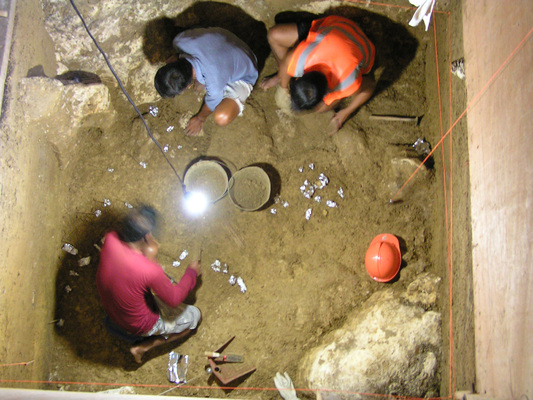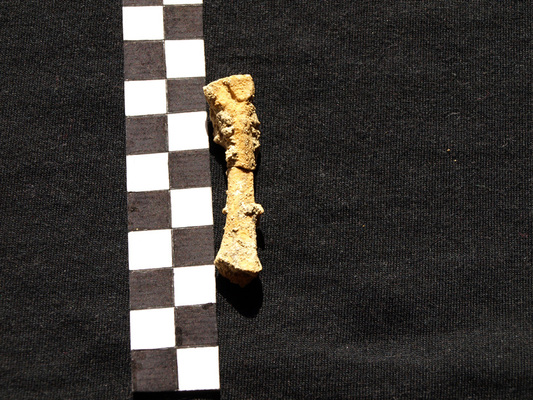
by Erin Wayman Thursday, January 5, 2012

Archaeologists excavating Callao Cave in the Philippines. Armand Salvador Mijares

This 67,000-year-old foot bone may be evidence of the oldest-known humans in the Philippines. Armand Salvador Mijares
Modern humans reached the islands of Southeast Asia by approximately 50,000 years ago, but our ancestors’ journey was not easy. Even during times of low sea level, a voyage to some of these islands would have required crossing open water, leaving many scientists to wonder how humans arrived on the most isolated islands. Now the story is growing more complicated: A group of archaeologists has discovered a 67,000-year-old foot bone that they say represents the earliest-known presence of humans in the northern Philippines and may be among the oldest-known traces of modern humans in all of Southeast Asia — that is, if the bone truly belongs to Homo sapiens. The bone’s small size and unusual features make it difficult to determine exactly which species of Homo it was — Homo sapiens, Homo floresiensis or something else?
In 2007, Armand Salvador Mijares of the University of the Philippines Diliman in Quezon City and colleagues uncovered the bone — a third metatarsal, one of the bones that makes up the middle part of the foot — while excavating Callao Cave on Luzon island. Nearly 3 meters beneath the cave’s floor, the team found the isolated foot bone encased in carbonized breccia. They dated the bone to a minimum age of 66,700 years ago using uranium-series radiometric dating. In a younger cave layer dated to 30,000 years ago, they recovered bone fragments of other animals, including a deer bone that contained cut marks — indirect evidence of human tools. In April and May 2009, the team found six additional bones with cut marks, Mijares says, but so far, no tools have been found.
Mijares and his colleagues recognized that the foot bone belonged to a primate, so they compared the metatarsal to the metatarsals of primates that inhabit Southeast Asia: macaque monkeys, gibbons, orangutans and Homo sapiens. They also included in the comparison Homo habilis, a species that lived in Africa 2.4 million to 1.4 million years ago.
The results were not clear cut, the team reported in the Journal of Human Evolution. They concluded that the Callao Cave bone belongs to the genus Homo, but it is unusual in several ways. The bone displays features — including odd curvatures and a narrow base — that are not seen in any species of Homo or in any other known hominin. And the bone is extremely small in its overall size and proportions. The team determined the bone is of an adult or adolescent, so the small size is not due to the individual being a child.
Although the Callao Cave bone is unique in many ways, the researchers offer several suggestions on the bone’s identity. First, the individual might have belonged to a population of pygmy Homo sapiens, similar in size to the small-statured Negritos that live in the Philippines today. Alternatively, the bone might have belonged to a member of a Homo erectus population. Homo erectus has been found in Southeast Asia, and some researchers think the species may have survived in the area until as recently as 70,000 years ago; however, very few Homo erectus foot bones have ever been found, making comparisons to the Callao Cave bone nearly impossible. Finally, the researchers point out that the bone is within the size range (and theoretical time range) of Homo floresiensis, or the “hobbit,” which has so far only been found on the island of Flores in Indonesia.
“It’s a compelling case that this is a bone that belongs to the genus Homo,” says Bill Jungers, a paleoanthropologist at Stony Brook University in New York who has studied Homo floresiensis. “Is it Homo sapiens? If I had to guess, probably yes,” he says. “I’d love to make the claim that this is an example of Homo floresiensis, but there just isn’t enough information.” Since the announcement of Homo floresiensis in 2004, anthropologists have debated whether it is a separate species or a malformed Homo sapiens. Finding a second population of Homo floresiensis would go a long way toward eliminating any lingering doubts that it is indeed a separate species, Jungers says.
Jeremy DeSilva, a functional morphologist at Boston University in Massachusetts, agrees that there is not enough information to make the claim that a second population of Homo floresiensis has been found. DeSilva is also hesitant to say whether this bone is even Homo. The bone’s unusual features are hard to explain away; thus, larger comparative analyses are still needed, he says.
This is what the team is working on now. Mijares’ co-author, Florent Détroit of the National Museum of Natural History in Paris, France, is conducting more analyses on the foot bone. Jungers has also offered the team access to his data on Homo floresiensis for further comparisons, Mijares says, something the team is now considering.
If the Callao Cave bone is indeed human, then “it’s exciting,” DeSilva says, and it adds to the scarce data regarding how humans colonized Southeast Asia. The earliest definitive evidence of modern humans in this region comes from 42,000-year-old bones found in Borneo and 47,000-year-old bones from Palawan, an island in the southwest Philippines. These islands would not have been difficult to get to during the glacial periods of the Late Pleistocene, when sea level was lower and land bridges connected many islands in Southeast Asia.
The island of Luzon, home to Callao Cave, is a different story. The island has never been connected to other landmasses via land bridges, Mijares and colleagues say, so humans would have had to cross the sea to get there. Such early ocean crossings may have been unintentional, as there’s no evidence of “boats, rafts or arks” from this period, Jungers says. Instead, he says, storms or tsunamis may have ripped chunks of land from the mainland — and any humans and other animals stuck on the floating debris may have been transported to the Philippines, Flores and other remote islands of Southeast Asia. A similar hypothesis has been used to explain how monkeys came to South America from Africa approximately 35 million years ago.
Finding more fossils from Callao Cave would help answer many of the open questions about the new foot bone, Jungers says. So far, Mijares’ team has not found any more human fossils in the cave, and they won’t be finding any more in the future. As of June 2009, the National Museum of the Philippines has claimed “exclusive rights” over the area and denied Mijares further access to the site, Mijares says. It is now up to the museum to continue the search.
© 2008-2021. All rights reserved. Any copying, redistribution or retransmission of any of the contents of this service without the expressed written permission of the American Geosciences Institute is expressly prohibited. Click here for all copyright requests.